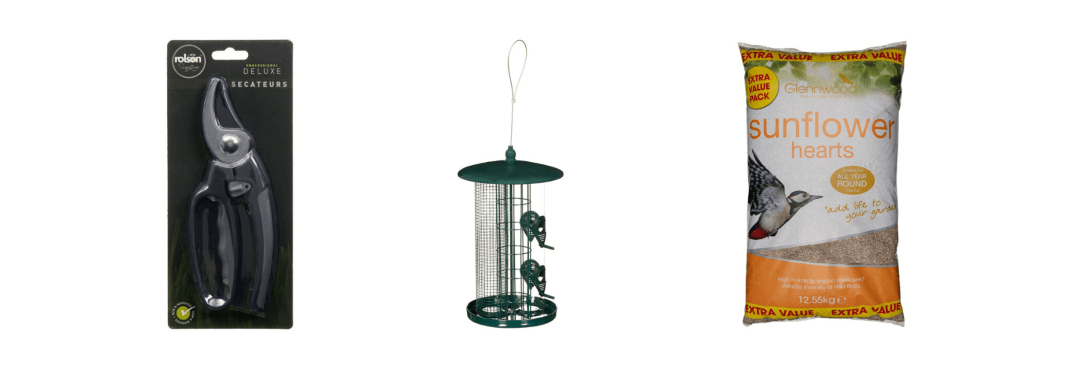8 Things To Do In Your Garden in February
10 February 2020

Gardening in February may not be the first thing on your mind - it’s cold, and many plants are still dormant.
However, light levels are improving - so why not support early flowers and prepare your garden for growing season by:
- Ordering plants and seeds
- Planting flower bulbs
- Pruning and tidying the garden
- Feeding birds
- Spring-cleaning outbuildings
- Pruning clematis and wisteria
- Sowing sweet peas
- Preparing vegetable plots
If you’re planning on cultivating a fruitful garden all year round, early spring is a good time to lay some groundwork for the seasons ahead. In fact, starting as early as February can help you to get a great deal done well in advance.
In this article, the team at B&M will explain what you can do at this time of year to keep your fruit trees and shrubs frost free, encourage the growth of spring flowers and help your garden to bloom.
Ordering Plants & Seeds
Most seeds stay viable for years, and many bulbs can be carefully stored for up to 12 months before planting. This quiet time provides a great opportunity to plan what you wish to add to your garden and stock up.
For something that is easy to grow, you can also purchase fully grown plants to be transferred into your garden when the weather improves a little.
B&M Top Tip: Give your plants a head start by sowing seeds into an indoor seed tray with a little fortified compost. Keep them watered and watch as they gradually sprout. Soon, they’ll be ready to transfer to your flower beds and planters!
The following plants should be sown indoors to be transferred outside once the weather warms up:
- Nemophila “Baby Blue Eyes”
- Aster “Ostrich Feather”
- Dahlia Figaro

Planting flower bulbs
Many plants that grow from bulbs, such as cyclamen, crocuses, daffodils and snowdrops will begin to send up shoots and even flower during February.
Add some colour to your garden by planting some of these bulbs.
B&M Top Tip: Display your flowering bulbs in a planter to really draw attention to the colours. It may also help to protect the plants from ground frost.
Pruning & Tidying the Garden
The period before the leaves return and all of your shrubs return to their spring or summer glory is the perfect time to prune. Pick up your shears or secateurs and make the most of this opportunity to clear some space and neaten the place up.
Feeding Birds
Nutrition can be scarce for garden birds during the colder months, so why not set up a bird feeder and fill it with some suitable tasty treats to keep them going? Once they get used to the location, they’ll be back time and time again to fill your garden with colour and song.

Spring-Cleaning Outbuildings
Make the most of quiet times like this to complete the chores you’ve been putting off. Clear any debris, cobwebs, dirt and unused items from your shed, garage or greenhouse and tend to any damaged or rusty pieces of equipment.
Pruning Clematis & Wisteria
Climbing plants can go completely crazy if they’re not cut back every so often - and it’s much harder to do this when they’re in full bloom. Prune them in the colder months, while they’re not flowering, to ensure they stay neat and tidy and don’t take over your garden!
Sowing Sweet Peas
Late winter or very early spring is a great time to start growing robust sweet pea plants. Use seed pots or trays to start with, then, when they’ve begun to sprout, you can transfer them outdoors.
Sweet peas are beautiful, colourful flowering climbers, so you’ll need to provide them with plant supports to help them reach full height. They have a gorgeous scent, so they’re very popular as cut flowers to be placed in vases around the house.
Preparing Vegetable Plots
Planning on growing your own? Preparing your vegetable patch or plot is a key part of gardening in February. Start by marking out the area you wish to use.
Next, start turning the soil and digging out weeds to make the ground’s nutrients easy to access and to ensure that planting is as easy as possible. Once your plot is planted up, water it regularly.

Cover any areas that aren’t being used yet with gardening membrane or mulch, as this will stop weeds from returning.
Most veggies should be planted between March and June, but if you’re planning on cultivating onions, you should get them in the ground as early as soon as the frost is gone.
Remember, some fruits and vegetables - such as tomatoes - rely on heat, so you’re best to cultivate them indoors.
B&M Top Tip: Wrap fruit trees with frost fleece to prevent damage.

So there you have it - February is the perfect month to get your garden ready for the year ahead, by ordering plants and seeds, planting bulbs, spring cleaning and pruning and preparing your vegetable patch. It’s also important to attend to wildlife at this time.
B&M Top Tip: Find the perfect recipe for your home grown veggies right here!
Got any winter and spring gardening tips of your own? Share them with the B&M Community via Twitter, Facebook or Instagram!





